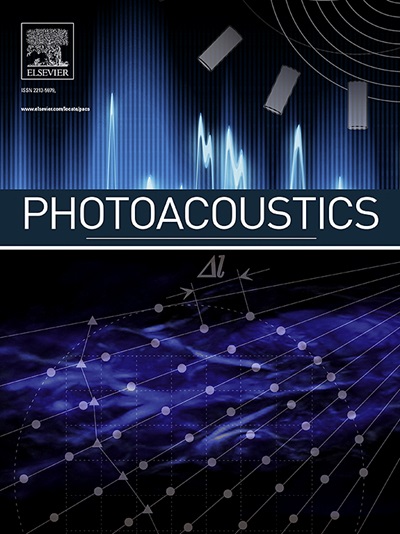高性能稀疏多光谱光声层析成像的多波长图卷积网络
IF 6.8
1区 医学
Q1 ENGINEERING, BIOMEDICAL
引用次数: 0
摘要
多光谱光声断层成像技术(MSOT)发展迅速,通过多波长激光激发和超声检测提供解剖和功能可视化,从而实现无标签生物医学成像。该技术为生物应用提供了高空间分辨率和深层组织成像能力。然而,高质量体内成像的硬件成本和计算需求阻碍了其广泛发展。为了克服这些限制,我们提出了一种用于稀疏MSOT的多波长图卷积网络。我们的方法通过结合多波长稀疏采样策略的图学习框架解决了病态稀疏重建问题,该策略可以建模和利用不同稀疏换能器配置的伪影分布中的内在相关性。综合小鼠体内实验表明,该方法为稀疏条件下的高性能稀疏MSOT成像提供了一种灵活实用的解决方案(16个传感器单元,重建SSIM为0.92 ± 0.01,PSNR为27.74 ± 1.27)。本文章由计算机程序翻译,如有差异,请以英文原文为准。
Multi-wavelength graph convolutional network for high-performance sparse multispectral optoacoustic tomography
The rapid advancement of multispectral optoacoustic tomography (MSOT) has developed for label-free biomedical imaging by providing anatomical and functional visualization through multi-wavelength laser excitation and ultrasound detection. This technique offers high spatial resolution and deep-tissue imaging capabilities for biological applications. However, the substantial hardware cost and computational demand for high-quality in vivo imaging hinder its extensive development. To overcome these limitations, we propose a multi-wavelength graph convolutional network for sparse MSOT. Our approach solves the ill-conditioned sparse reconstruction problem through a graph learning framework integrated with a multi-wavelength sparse sampling strategy, which can model and leverage the intrinsic correlations in artifact distributions across diverse sparse transducer configurations. Comprehensive in vivo mouse experiments demonstrate that the proposed method provides a flexible and practical solution for high-performance sparse MSOT imaging under sparse conditions (16 transducer elements with the reconstruction SSIM of 0.92 ± 0.01 and PSNR of 27.74 ± 1.27).
求助全文
通过发布文献求助,成功后即可免费获取论文全文。
去求助
来源期刊

Photoacoustics
Physics and Astronomy-Atomic and Molecular Physics, and Optics
CiteScore
11.40
自引率
16.50%
发文量
96
审稿时长
53 days
期刊介绍:
The open access Photoacoustics journal (PACS) aims to publish original research and review contributions in the field of photoacoustics-optoacoustics-thermoacoustics. This field utilizes acoustical and ultrasonic phenomena excited by electromagnetic radiation for the detection, visualization, and characterization of various materials and biological tissues, including living organisms.
Recent advancements in laser technologies, ultrasound detection approaches, inverse theory, and fast reconstruction algorithms have greatly supported the rapid progress in this field. The unique contrast provided by molecular absorption in photoacoustic-optoacoustic-thermoacoustic methods has allowed for addressing unmet biological and medical needs such as pre-clinical research, clinical imaging of vasculature, tissue and disease physiology, drug efficacy, surgery guidance, and therapy monitoring.
Applications of this field encompass a wide range of medical imaging and sensing applications, including cancer, vascular diseases, brain neurophysiology, ophthalmology, and diabetes. Moreover, photoacoustics-optoacoustics-thermoacoustics is a multidisciplinary field, with contributions from chemistry and nanotechnology, where novel materials such as biodegradable nanoparticles, organic dyes, targeted agents, theranostic probes, and genetically expressed markers are being actively developed.
These advanced materials have significantly improved the signal-to-noise ratio and tissue contrast in photoacoustic methods.
 求助内容:
求助内容: 应助结果提醒方式:
应助结果提醒方式:


